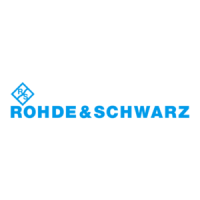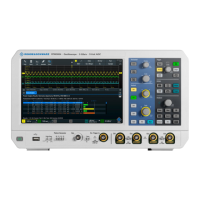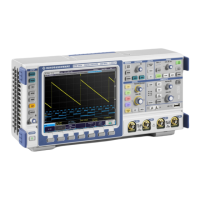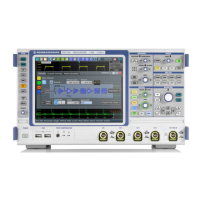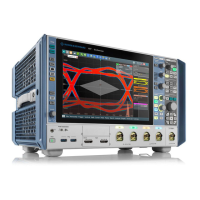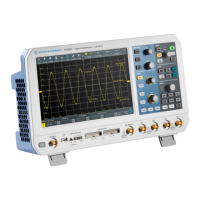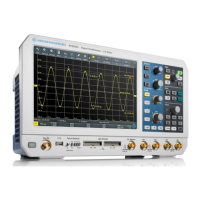Power analysis (option R&S RTM-K31)
R&S
®
RTM3000
376User Manual 1335.9090.02 ─ 09
●
the power waveform that is the product of the current and voltage waveforms
●
numeric measurement results
For a detailed description of the numeric results, see Chapter 14.5.1.1, "Ripple
results", on page 359.
Also, for each measurement result you can enable a statistic evaluation of the mea-
surement results. It returns the current, minimum and maximum measurement values,
the average and standard deviation, and the number of measured waveforms.
14.7.1.2 Configuring efficiency measurements
For details of the configuration settings, see Chapter 14.7.1.3, "Efficiency settings",
on page 377.
1. Press the Apps Selection key. Tap "Power Analysis".
2. In the "Power Path" tab, tap "Efficiency".
3. Connect the differential voltage probe and the current probe to the oscilloscope.
It is recommended that you use a high-voltage differential probe for measurements
at the DUT power input.
4. Demagnetize the current probe. For details, see the user manual of your current
probe.
5. Select the "Tools" tab.
6. Connect the probes to the R&S RT-ZF20 power deskew fixture.
7. "Deskew" the probes and adjust the "Zero Offset".
8. Disconnect the probes from the R&S RT-ZF20 power deskew fixture.
9. Connect the probes to the DUT:
● Connect the positive (+) signal socket of the first differential probe to the line of
the AC input.
● Connect the negative (-) signal socket of the first differential probe to the neu-
tral of the AC input.
● Connect the first current probe to the line of the AC input.
● Connect the positive (+) signal socket of the second differential probe to the
input path of the load.
● Connect the negative (-) signal socket of the second differential probe to the
return path of the load.
● Connect the second current probe to the input path of the load with the direc-
tion of the arrow pointing towards the current flow.
10. Close the "Power Analysis".
11. Press the "Menu" button and scroll to the "Power" menu.
12. Select the correct channels for the "Input Voltage", "Input Current", "Output Volt-
age" and "Output Current" sources.
Power path power measurements
